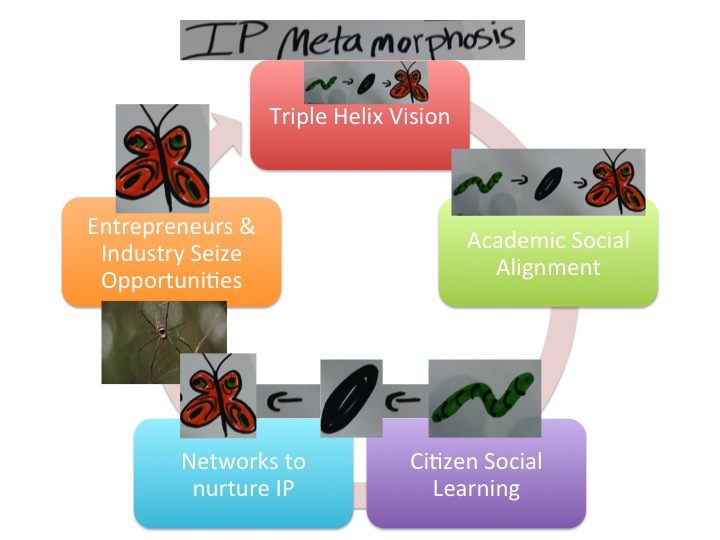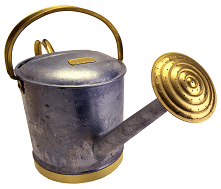Contributing Author: Mei Lin Fung
It’s the end of a busy week, which included the Triple Helix IX Stanford conference, where I was privileged to be on the steering committee. Overseas and out of state visitors just left to go home, and my head is filled with reflections having spent the week with people working at the Triple Helix intersection of Government, Industry and Universities.
 |
The highlight of the conference was the playing of the Trilicious Game – a board game designed by Luke Hohmann, CEO of Innovation Games. People from around the world, townships, universities and industry picked from a list of problem scenarios which included Aging Population, Corrupt Government, Intellectual Property Rights and others. We were given sets of tools to try to solve these problems – the tools were divided into 3 classes roughly reflecting the different perspectives of Academics (Knowledge Tools), Industry (Innovation Tools) and Government (Consensus Tools). |
Happily I found myself with 3 technology transfer officers from Brazil, and a lady from Denmark (Academia), a Silicon Valley consultant in Scenarios (with clients in Industry & Government) and I brought in a mixed Industry & Government perspective from my work at Intel, Oracle and most recently as a Support Group member of the US Federal Health Futures Group.
Within 45 minutes we came up with an amazing set of 12 new innovations, all part of an overall story line which we called the IP Metamorphosis. This sketch above barely scratches the surface, but the wondrous thing is how a set of strangers can develop a powerful metaphor so quickly – on how the seed of intellectual property can begin in universities but must be transformed in a “Pupae” stage before it can emerge as the butterfly of Intellectual Innovation which can transform societies as entrepreneurs and industry determined to achieve, succeed in commercializing. The importance of social learning as a means of developing future entrepreneurs and creators of intellectual property and innovation also emerge, as each of us struggled with how to transform from industrial and manufacturing societies to knowledge economies. It was an inspiring 1.5 hours in which we realized that answers are not so far away, if we can convince ourselves to search together.
There are quite a number of reasons for citizens of California to be concerned in 2011 – as the state budget is causing a double punch of job loss and cutting into vital services like firefighters, police, teachers. Then there is the whole dark cloud of healthcare…. Much to cause concern, and for the best of us, to ask, what can we do? Especially in Silicon Valley.
 |
What should we do? How can we contribute to making things better? Can one person, like me, make a difference? As I consider the issues, I know one thing for certain, if we can make things better, if we want to turn things around and go from dread and complaining, it will be humans who will do it. And they won’t be the usual suspects, the ones who have been in charge of things, well let’s say the best they could do has not been enough. |
So I invite you to take step with me, away from the stifling meeting rooms, filled with tension and stress, into the sunlight, out into the garden. And what do we see? Growth. How does it happen? The plants grow nourished by that bright sunlight, and water, nutrients in the soil. If these are provided. They grow, if they are missing, the plants wilt and may die. Why does it seem so simple out there in the garden and so difficult in the meeting room to work out how to grow happy thriving lives, under the bright California sunshine, as has been happening for a very long time?
What does it take to nurture a life? We are born with this knowledge in us, like a tiny seed contains all the possibility of the great plant it can grow into.
|
When we notice someone, and they know we are paying attention – that is like the sunlight, they will turn to our attention, like a plant turns to sunlight. We can always give the gift of our attention, and it can make a huge difference in the ones we provide that gift to. Reflect on the last time you gave the gift of your interest and kindly attention to someone, your spouse, your child, a friend, a colleague or a stranger. Take a moment to write down how they responded. Now write down how you felt. When we praise, well that is like a precious nutrient – each tiny atom or molecule of praise helps another part of someone’s life to grow, that might not have had the chance to grow if you did not notice that potential and encouraged it by your attention and praise. Think of an instance when you took the time to consider someone’s potential, offering the nutrient of praise. What did the person do afterwards? Try it. |
.jpg) |
 |
Try it mindfully, with intention to encourage those you interact with, to develop their potential to contribute to the world. Finally, we humans are 80% made of water. So for the nurturing of a person we can offer trust, we can offering our caring and we can offer our love. No one is able to do everything they want to all the time, or be who they want to be all the time. When they stumble, when they tire, help them get themselves up, shake themselves down, start all over again. I hope you can find your voice to nurture the seeds of possibility all around you. Each of us in the world of events willaffect the time and lives of hundreds of people. By taking the attitude, of spreading the sunlight of your attention, the catalyst of your encouragement and the life-force of your energy and care, there is no doubt whatsoever in my mind that you will succeed even beyond your wildest dreams. Speak up to Encourage, to Catalyze and to Invigorate. Your Voice Counts! |

